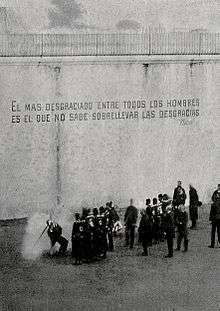Capital punishment in Uruguay
Capital punishment in Uruguay was abolished from its legal system in 1907 by Law N° 3238 passed during the government of president Claudio Williman and later removed from the constitutional system in 1918. It was established by Uruguayan Constitution of 1830.

History
Colonial period
Capital punishment was applied since the time of Spanish colonization in the current territory of Uruguay. The usual method of execution was by hanging and by firing squad in case of military or political crimes.[1]
Shortly after beginning his term as governor of Montevideo, Agustín de la Rosa in 1764 had the initiative to raise a gallows in the nowadays known as "Constitution" square to "strengthen the peacefulness of the population and to frighten restless people".[1] Occasionally, in particular when it was dealing with white people, death penalty was performed with the device known as "garrote".
Constitution of 1830
In the first constitution of the recently born Uruguayan state, death penalty is implicitly mentioned in its articles 26 and 84, that regulates the powers of the Chamber of Representatives and the presidential pardon.[2]
It is incumbent on the Chamber of Representative:
2°) The exclusive right to accuse before the Senate, the Superior Head of the State and his Ministers, the members of both Chambers and the High Court of Justice, for crimes of treason, concussion, embezzlement of public funds, violation of the Constitution, or others which deserve infamous or death penalty, after having taken over about them, at the request of a party, or from one of its members, and declared to have merit to the formation of a cause. — Article 26, Constitution of 1830
The President of the Republic shall have the prerogative to pardon the death penalty, after a report from the Court, or Judge, before whom the case is pending, in crimes not excepted by law, and when there are serious and strong reasons for it; also the one of not being able to be accused during the time of his mandate but before the Chamber of Representatives, and for the crimes mentioned in article twenty-six; and the one that this accusation can only be made during the exercise of his functionsor a year later, which will be the term of his residence, after which no one will be able to accuse him. — Article 84, Constitution of 1830
Abolition
Death penalty was abolished by Law N° 3238 of 23 September 1907, during the government of Claudio Williman, which in its Article 1° provides:
The death penalty established by the Penal Code is abolished. The death penalty established by the Military Code is also abolished.
This law was unconstitutional at the time of its promulgation, since the Constitution of 1830, then in force, made explicit references to the death penalty in its articles 26 and 84 (see above). But it is also worth to note that this Constitution did not provide any system to allow nullifying laws that opposed to its terms, as it exists today in current Constitution.
The last execution was performed in Maldonado Department in 29 September 1902.
This law was passed after hard debates between abolitionists and anti-abolitionists, which were particularly arduos regarding the suppression of the death penalty for military crimes.[3]
In 1918, the abolition became constitutional by being included in the new Magna Carta that came into force that year, in which is stated:[4]
The death penalty shall not be applied to anyone. — Article 163, Constitution of 1918
All subsequent constitutions have upheld that prohibition. It can be found in current Constitution (1967) in article 26.[5]
References
- Arregui, Miguel. "Milonga para los últimos fusilados" (in Spanish). El País. Retrieved 22 April 2020.
- "Constitución 1830. Promulgada el 28 de junio de 1830" (in Spanish). Parliament of Uruguay. Archived from the original on 21 October 2013. Retrieved 22 April 2020.
- Fessler, Daniel. "Delito y castigo: Del Código Penal a la abolición de la pena de muerte" (PDF) (in Spanish). Archived from the original (PDF) on 10 June 2015. Retrieved 14 November 2013.
- "Constitución 1918. Plebiscitada el 25 de noviembre de 1917" (in Spanish). Parliament of Uruguay. Archived from the original on 16 December 2013. Retrieved 22 April 2020.
- "Constitución de la República" (in Spanish). IMPO. Retrieved 22 April 2020.